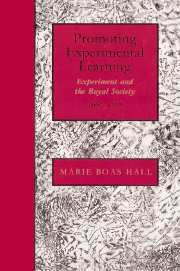Book contents
- Frontmatter
- Contents
- List of figures
- Preface
- A note on dates
- 1 Introductory
- 2 Aims and ideals
- 3 The record of the minutes 1660–1674
- 4 The communication of experiment 1660–1677
- 5 The record of the minutes 1674–1703
- 6 The communication of experiment 1677–1803
- 7 The record of the minutes 1703–1727
- 8 The communication of experiment 1703–1727
- 9 The view of the world; friend and foe
- Abbreviated titles
- Notes
- Bibliography
- Index
7 - The record of the minutes 1703–1727
Published online by Cambridge University Press: 03 December 2009
- Frontmatter
- Contents
- List of figures
- Preface
- A note on dates
- 1 Introductory
- 2 Aims and ideals
- 3 The record of the minutes 1660–1674
- 4 The communication of experiment 1660–1677
- 5 The record of the minutes 1674–1703
- 6 The communication of experiment 1677–1803
- 7 The record of the minutes 1703–1727
- 8 The communication of experiment 1703–1727
- 9 The view of the world; friend and foe
- Abbreviated titles
- Notes
- Bibliography
- Index
Summary
With Hooke's death there was to be a very considerable change in the Royal Society's activities. This was not quite the same situation as had arisen in 1677 when the death of a very active Secretary demanded as well as permitted change; it was rather that the death of Hooke, a former Secretary and more or less perpetual Curator of Experiments, de facto if not de jure, since 1662, made possible the installation of a new President (for Newton would never have accepted election while Hooke was alive), and this in turn led to the appointment of a new Curator of Experiments. Newton was to play an active part in the Society's affairs, presiding over the vast majority of meetings, commenting on, occasionally presenting experiments, and above all helping to guide the presentation of experiments, now far more numerous than had been the case in preceding decades, for the next fifteen years. After this, in Newton's extreme old age, the momentum generated previously then continued for another decade. The presence of a new Curator of Experiments (not always so called) totally revolutionised the Society's meetings. Francis Hauksbee, who suddenly appeared at the Society in December 1703 at the first meeting at which Newton presided, was to make the presentation of experiments once again an important feature of meetings from this time until shortly before his death in the spring of 1713.
It is obvious that the very existence of a Curator of Experiments is likely to generate the presentation of experiments at meetings, for Curators had to present experiments with some regularity to justify their existence (and salary).
Information
- Type
- Chapter
- Information
- Promoting Experimental LearningExperiment and the Royal Society, 1660–1727, pp. 116 - 132Publisher: Cambridge University PressPrint publication year: 1991
